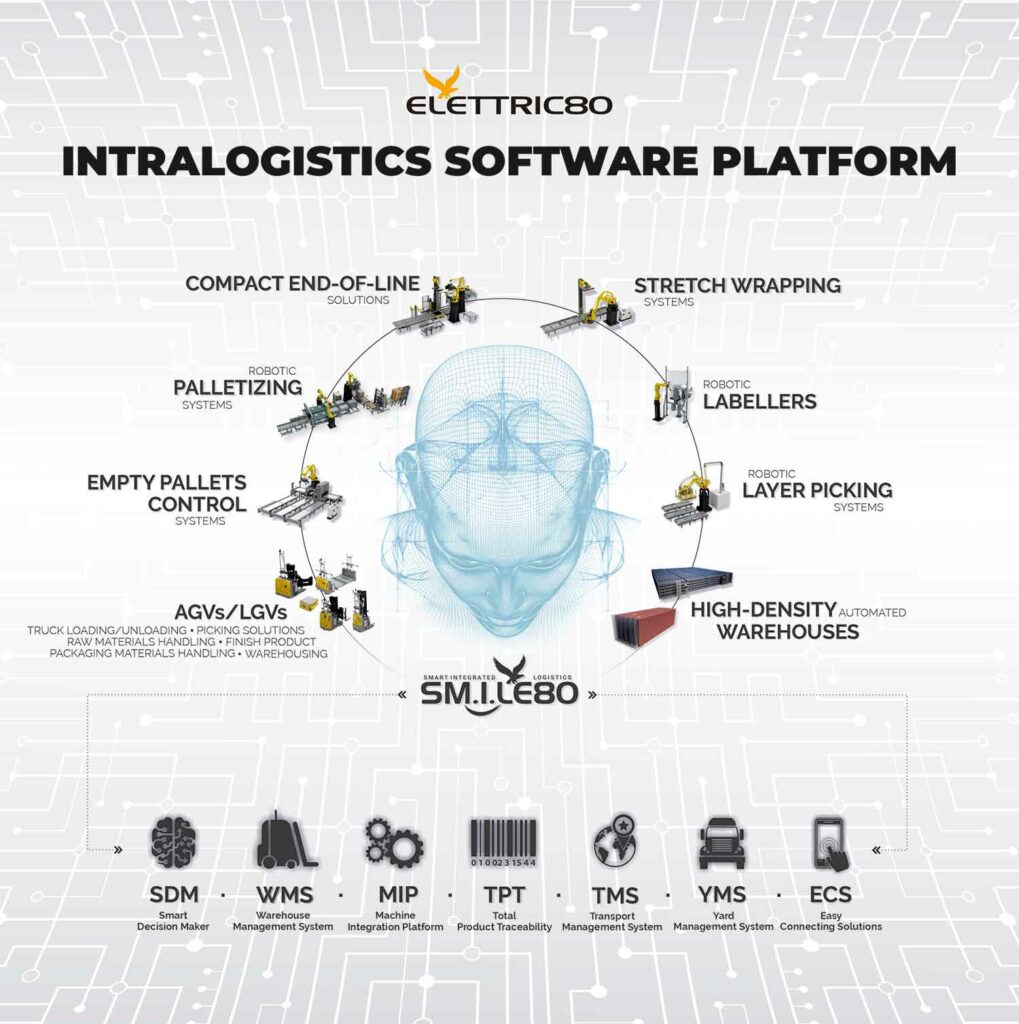William Nelson, President, Elettric80, explains how a fit-for-purpose logistics system is only as good as its driver … its brain making nanosecond decisions all day, every day.
What makes automation projects successful? Is it the hardware? Good operators? Luck? The answer is likely a mix of hardware and good operations management but two critical elements, arguably the most important of all, are missing.
Just think about it for a while
Planning and system design are without doubt the most important elements to reach the highest level of performance, repeatability, and cost-effectiveness. Experience in mining and interpreting information and diligence in data crunching round out the system design process. For the Elettric80 Group (E80), we have been demonstrating this since 1992, during the initial implementation of our first automatic guided vehicle.
The main objective of the system engineer, system analyst and business analysts is to develop a concept layout, test the concept under all conditions through real world simulations and write the narrative around the entire set of functions and “what if” scenarios that can occur in any given second. But this is not the end of the story.
The brain of any system drives its performance, and this is where things get really interesting. In effect planning, system design, data crunching, simulation and the functional design story inform the development of an integrated software platform that, like a conductor of an orchestra, ensures that all pieces of any automation play, work, harmoniously and complementarily.
An integrated software platform combines the following elements and functions:
• Decision making software (SW) to optimise utilisation of resources and prioritisation of work. This SW uses native information obtained through the planning and design process outlined above to establish priorities and define processes, and uses artificial intelligence (AI) to predict and assimilate to changing conditions
• Smart mission management SW to direct resources towards work, shorten or swap missions to reduce mission time and release missions in faster successions
• Predictive traffic management to make traffic flow without interruptions, blocking intersections and intelligent route selection
• Real time system management tools such as web-based visual operator interface to observe, control and adjust missions if required.
It’s the brain that makes the difference
As with world-class athletes, a truly high-performing automation systems starts with a sharp, well-trained brain connected to strong and flexible extremities (HW). Obviously, the quality of both elements (SW and WH) is fundamental to the success of an automation system as both are intertwined and one cannot function without the other.
The brain of a system is the most underrated aspect for many prospective buyers. Sure, we’re all used to kicking the tires on equipment, it’s the most tangible sensation we can gather and process. But let’s not forget where this all starts: with the brain. An automation system is only as good as its driver which in this case is its SW brain that commands, adapts in real time and makes nanosecond decisions all day, every day.
Sure, you can all relate to feeling foggy in the head some days and how that affects your decision making and reaction time. The same holds true for automation – clear ideas lead to outstanding results. Your SW provider will demonstrate this through analysis of your business practices followed by comprehensive E-2-E testing prior to arrival at site.
If it seems too good to be true…
It’s interesting to see the proliferation of a vast array of automated mobile robots (AMR) in the marketplace today. Surely the logistics world will benefit from the capabilities of these machines. Indeed, AMR offer a partial, but very limited set of capabilities to the automated logistics toolbox.
AMR are touted as easy to install, flexible lower cost alternatives to other mobile automation technologies and under certain specific circumstances this is true.
For the most part, however, AMR offer only a limited range of activities and capabilities and cannot be considered as a solitary solution in multifunctional logistics projects. AMR manufactures will glowingly promote their simple navigation systems, configurable layouts and traffic control systems, however the devil, as always, lies in the details and in this case the details are important to distinguish in system planning and design.
In reality, most logistics systems require multiple functionalities such as lifting to various heights many kinds of materials of varying weights and shapes. They also include changing environments from production replenishment to warehousing to raw material handling to truck loading and unloading.
This is just a snapshot of examples of the practically unlimited logistics requirements E80 has found and supplies today. In these multiple use scenarios laser guided vehicles (LGV) provide the best overall performance due to their flexibility, precision and repeatability that cannot be replicated by AMR. And let’s not forget the most important element: connecting the brain to the extremities.

Go together and go farther
The biggest mistakes we see in logistics automation project planning and system design are apparent when the designer takes short cuts due to insufficient/overall project scope definition, overestimation of system capabilities and/or sales pressures. This has made for many “one and done” system applications. In fact, many early adaptors in far too many cases have paid the price for the panacea of a “one-size-fits-all” solution promoted by some suppliers.
On the other hand, other users of logistics automation have prospered and grown through a different approach – a diligent research of supplier capabilities that leads to a strong collaborative partnership to develop custom solutions suited to provide a competitive advantage. The track record of success of these forward-thinking companies is astounding. There are many examples that I could site of companies who choose integrated automation including brain, extremities, and feedback (integrated SW, HW, AI, IoT data acquisition) over less comprehensive, more short-term solutions.
Additionally, LGV solutions are fully flexible to be reconfigured over time as business needs evolve. Reconfiguration could include added production lines, drop points, increased SKU types, whatever the mind could imagine, it’s been requested. In fact, LGV solutions are not only flexible but extremely durable solutions – with many of the systems in place reaching 20+ years of functional life due to the robust design of the HW and the power of the SW platform. As the saying goes: you get what you pay for.
No shortcuts
Another aspect to consider when choosing a logistics automation solution is a company’s technology development capabilities and its speed to market. We already discussed the importance of planning, system design, E-2-E simulation and the value of an integrated SW platform capable of meeting present and future requirements.
Automation companies are popping up like mushrooms after rain. How many will be around in the future is anybody’s guess. Companies with a solid track record in LGV/ARM automation that can really back up their marketing claims are few in number. The best companies have compiled a long history of success through repeat business and partnership with industry leading consumer products companies (CPG). They also dedicate a significant amount of their income to R&D in products that promote safety such as Ultra-Wide Band sensing (UWB), mixed navigation systems (laser and ambient), integrated SW platforms that combine smart LGV mission management, WCS, MES, YMS and all data tracking tools to ensure quality and traceability. To this purpose, E80 continues its investments in research year after year and it has now advanced its AGV/LGV safety initiatives with the launch of SmartDect® ultra-wideband (UWB) technology – a short-range RF technology for wireless communication that can detect the location of people, assets (AGVs/LGVs) and objects with unrivaled precision.

Crucial to the success of any project is the capability of your supplier to interface to upstream and downstream processes such as rewinder lines for parent roll delivery or palletisers, truck doors and customer ERP in seamlessly transparent way allowing you to oversee all aspects of your operation through one user interface tool. Ideally, a one-stop-shop where you can access all the above and a wide range of hardware suited to any need is the best guarantee of success.
There are cases, however, were mixing fleets merits consideration. Some companies have developed tools to manage AMR/LGV fleets under one umbrella. These implementations require careful scoping, planning and clear delineation of individual company responsibilities.
As in any case, saying is easier than doing. The experience of a supplier that has grown to know the intricacies of your processes and not just some pretty hardware is what has proved a winning proposition for those companies that have ventured into the world of logistics automation. Planning and system design are without doubt the most important elements to reaching the highest level of performance, repeatability, and cost-effectiveness. We can aspire to the glossy images of “magical thinking” but there’s no substitute for the tedium of hard work combined with experience and industry-leading integrated SW and HW products on the way to profits.

































